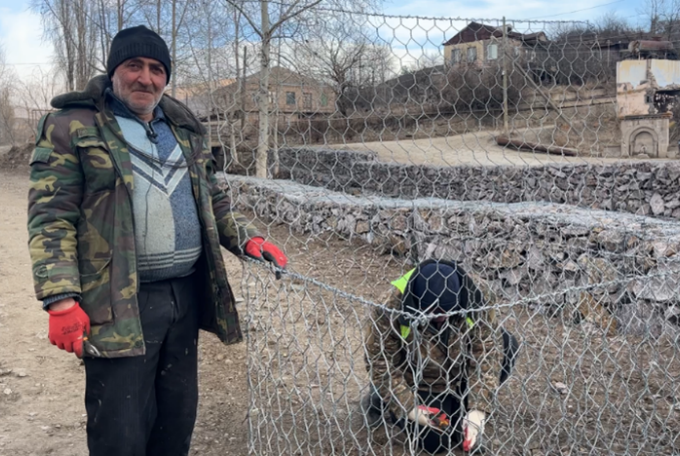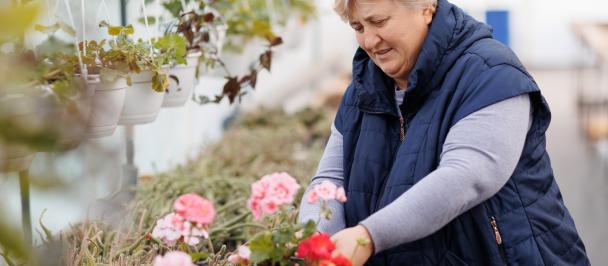Nature-based solutions help reduce risk to climate hazards in Armenia
February 1, 2023

According to the latest official figures, Armenia has experienced a 1.2° C rise in average temperatures and a 20 percent increase in extreme weather events over the last century. As a landlocked country with complex mountainous territory and vulnerable agricultural regions, climate change poses a serious threat to communities and livelihoods across the country.
The Gegharkunik province is one of the regions in Armenia most exposed to climate-induced risks and hazards, including spring-frost, hailstorms, winds, drought, and mudflow. Mudflow is particularly threatening. The mudflow channels are in poor condition, filled with mud and debris throughout the year, causing severe problems during the spring rain season and after winter snowmelt in the nearby mountains.
The mudflow channels are now cleaned and riverbank protection walls constructed in Chambarak community thanks to the programme "Supporting Nationally Determined Contributions Towards Climate Risk Resilience in Armenia" programme funded by the Japanese Government and implemented by UNDP. These activities are important to support the community’s development, reducing disaster risks and protecting existing and future investments from the impacts of climate change. For instance, crucial road renovation and asphalt paving projects that were delayed for years due to possible damage from mudflows, are now able to resume, as the risk of mudslide damage has been reduced to a minimum.
One of the most important aspects of the project is the application of nature-based solutions for mudflow risk reduction. The riverbank works used galvanized gabions filled with basalt-based stones and rocks from the quarry near the community, instead of concrete retaining walls. Because they employ a natural solution, the gabions have a number of advantages such as being able to undergo deformation and release drainage water. Moreover, they are cheaper and more durable.
According to the residents of Chambarak, the cleaning of the community mudflow channels and the construction of the riverbank protection gabions, using the locally available stones (from riverbed and surroundings), will positively impact community development in several directions.
"Every year, including in the summer, due to the closure of the mudflow channels, the mudflows use to come out of the already deteriorated concrete barriers and submerge our gardens, flooding them and damaging our crops”, said Susanna Avagyan, a teacher in the community. “Now that these channels are cleaned, and these gabions have been installed, we will be able to do gardening without fear that the mudslides will damage our gardens and the land near our homes. We also hope that the roads, the repairs of which were impossible due to the mudslides, will be asphalted soon."
The project also sought to develop local capacities, so the construction works were carried out by eightresidents. Therefore, they are now able to carry out similar works as well asorganize further gabion maintenance properly. The applied nature based solutions will have a positive effect on several local businesses as well, such as the "Hatsatun" dinery, a unique environment for active community participation, where local events and gatherings take place.
“The walls of the building were repeatedly damaged by mudslides, bringing a large amount of garbage and sludge that would fill the bakery and the surrounding area," an employee of the “Karine Sulyan” dinery said. Following the construction works, she hopes that the mudslides will not damage the building anymore.
The positive results of this intervention point to the multi-faceted benefits of adaptation and resilience investments. As the impacts of climate change intensify, scaling-up adaptation, resilience, and disaster risk reduction tools, and ensuring they are available to vulnerable groups of the population, will become ever more crucial.
Moreover, using nature-based solutions to address climate change adaptation helps to conserve and restore the nature, addressing challenges, such as land degradation and loss of soil organic carbon. Measuring the impact and communicating the success of nature-based solutions are essential to informing present and future policies for further scale-up and replication.
***
Japan considers that the climate crisis is a threat to all humanity and, in cooperation with UNDP, leads countries to accelerate their climate action.
In 2021, UNDP launched a new phase of Climate Promise – From Pledge to Impact – aimed at translating NDC targets into concrete action. Japan is the largest supporter of this phase and joins longstanding partners such as Germany, Sweden, the European Union, Spain, and Italy and new partners such as the United Kingdom, Belgium, Iceland, and Portugal to accelerate these efforts.

 Locations
Locations



